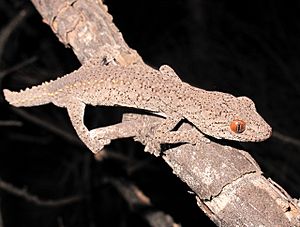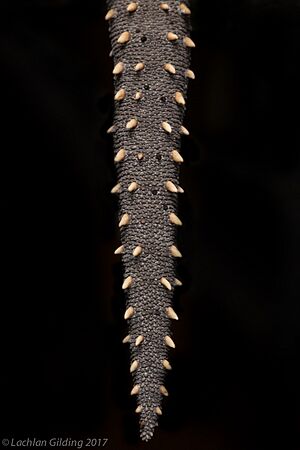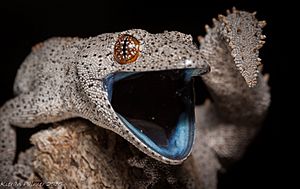Strophurus williamsi facts for kids
Quick facts for kids Strophurus williamsi |
|
|---|---|
 |
|
| Eastern spiny-tailed gecko in Pilliga forest, NSW, Australia | |
| Conservation status | |
| Scientific classification | |
| Genus: |
Strophurus
|
| Species: |
williamsi
|
| Synonyms | |
|
|
The eastern spiny-tailed gecko (scientific name: Strophurus williamsi) is a cool type of lizard. It's also known as the soft-spined gecko or Williams' spiny-tailed gecko. This gecko belongs to the family called Diplodactylidae.
You can only find this gecko in the dry, semi-desert areas of eastern Australia. This includes parts of Queensland, New South Wales, Victoria, and South Australia. People sometimes keep them as pets because of their unique tails. These geckos are special because they live in trees and are active during the day. Most other geckos are active at night.
Contents
- What Does the Eastern Spiny-tailed Gecko Look Like?
- Why Is It Called That?
- Eastern Spiny-tailed Gecko Family Tree
- Where Do Eastern Spiny-tailed Geckos Live?
- Where Can You Find Eastern Spiny-tailed Geckos?
- Reproduction and Life Cycle
- What Do Eastern Spiny-tailed Geckos Eat?
- Threats to Eastern Spiny-tailed Geckos
What Does the Eastern Spiny-tailed Gecko Look Like?
The eastern spiny-tailed gecko is a small, thin lizard. It grows to about 6 cm long from its snout to its body, with a tail of about 5 cm. Their bodies are usually grey with darker brown or grey patches and spots. Some geckos might have a diamond or net-like pattern on their backs. Their bellies are pale grey or white with small dark spots.
During the day, these geckos often warm up in the sun on thin branches. Their camouflage helps them blend in and hide from animals that might want to eat them. Their eyes have a bright orange or red ring around the dark middle part. Their toes are long and wide, with special sticky pads that help them climb.
A key feature that sets this gecko apart is the rows of large bumps along its tail. These bumps, called tubercles, form four lines along the tail and are orange. Scientists believe these tails help protect the gecko from predators. They also use their tails in special displays.
These geckos have a unique defense! They can squirt a sticky, smelly liquid from glands on their tail. This liquid is made of protein and can be aimed at a predator by curving the tail. Studies show that geckos that can squirt this liquid are less likely to lose their tails. This is important because many other geckos simply drop their tails to escape.
Another way they defend themselves is by taking a special pose. They lift and arch their body, stretch out their throat, and slowly wave their tail. During this display, they open their mouths wide to show off their bright blue or yellow insides.
You can tell male geckos from females by looking at small scales near their cloaca (a body opening). Males usually have one to five larger scales in a diagonal row. Females have one to three smaller scales. Males also have special pores that females do not.
Why Is It Called That?
The scientific name, williamsi, was given to honor an American scientist named Ernest Edward Williams. The common name, 'Eastern spiny-tailed gecko', describes its unique tail with spike-like bumps.
Eastern Spiny-tailed Gecko Family Tree
The Strophurus group of geckos is one of only two lizard groups with special defense glands on their tails. Many species in this group also have colorful patterns on their eyes, tails, and mouths. There are currently 20 species in the Strophurus group. They used to be part of the Diplodactylus group, which mostly includes geckos that live on the ground.
- Kingdom: Aniimalia (Animals)
- Phylum: Chordata (Animals with backbones)
- Class: Reptilia (Reptiles)
- Order: Squamata (Lizards and snakes)
- Family: Diplodactylidae
- Genus: Strophurus
- Species: S. williamsi (Kluge, 1963)
Where Do Eastern Spiny-tailed Geckos Live?
Eastern spiny-tailed geckos live in many different types of environments. They prefer habitats like dry sclerophyll forest, savanna, and eucalyptus woodlands. They have also been found near the edges of rainforests.
Earlier studies showed that these geckos are often found under loose bark on Callitrius pine or Ironbark trees. They also live in tree hollows and on tree trunks. You might also find them in shrubs, Spinefex, Casuarina, and Leptospermum plants. At night, when they are most active, they search for food on the ground around grassy bushes. Some populations even live in savannas without trees, so they might use other hidden spots too.
Where Can You Find Eastern Spiny-tailed Geckos?
In Australia, S. williamsi lives in north-eastern New South Wales, Queensland, south-eastern South Australia, and north-western Victoria. They are found in patches across eastern Australia, from Cairns in Queensland down to Adelaide in South Australia. They are also found as far west as Bourke in New South Wales.
You can often find them in the Murray-Darling woodlands and mallee ecoregion in Victoria. In central New South Wales and south-west Queensland, they mostly live in semi-dry areas. They prefer temperatures between 25-30 °C.
Reproduction and Life Cycle
The breeding season for eastern spiny-tailed geckos is from September to February. These geckos lay eggs, which means they are oviparous. The female lays two eggs at a time, usually twice in a season. They lay their eggs at the base of trees, under rocks, or in old animal burrows.
The eggs hatch in about 45–80 days. This happens best when the temperature is between 27 °C-30 °C and the air is 70-80% humid. The baby geckos can start eating just three to five days after they hatch. Females can lay new eggs very quickly, sometimes just an hour after laying the previous clutch. On average, a female can lay five sets of eggs each year.
What Do Eastern Spiny-tailed Geckos Eat?
Eastern spiny-tailed geckos are insectivores, which means they mostly eat insects and other small creatures. Their main diet includes crickets, grasshoppers, moths, spiders, and termites.
Threats to Eastern Spiny-tailed Geckos
The IUCN (International Union for Conservation of Nature) has listed Strophurus williamsi as a species of "least concern." This means they are not currently a main focus for conservation because they are not highly threatened.
However, these geckos can be affected by grazing animals and by losing their habitat. This often happens when land is cleared for farming. Animals that prey on the eastern spiny-tailed gecko include wild cats, larger lizards like goannas, and birds of prey. They are also sometimes eaten by the pale-headed snake.




